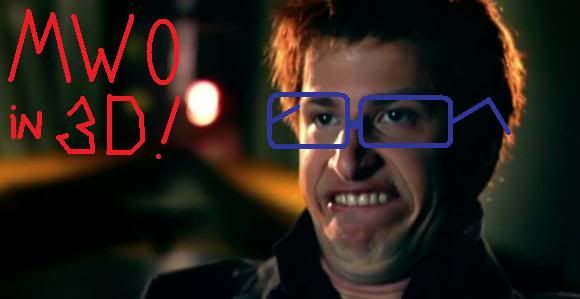 Kyle Hawkins, on 06 April 2012 - 08:38 PM, said:
Kyle Hawkins, on 06 April 2012 - 08:38 PM, said:
Oh yeah, of course, each game or title that intended to use it would certainly need to be tailored to accommodate, but so do regular stereoscopic 3D techniques, or any game with force feed back and such features. I don't agree with the idea that you need current stereoscopic 3D display tech to make 3D games look right though.
Well, unfortunately the reality is that you DO need stereoscopic display technology to make 3D appear to be 3D in the strictest of senses.
 Kyle Hawkins, on 06 April 2012 - 08:38 PM, said:
Kyle Hawkins, on 06 April 2012 - 08:38 PM, said:
I've been to see 3D movies, and I've stood in the stores testing out the various 3D TV brands. The types with and without glasses. Whilst it's a nice trick, it doesn't look right. It was all very "meh". It looks like a trick, or an illusion. Fake. The reason being that these displays can't give you true perspective on what you're looking at. It's more like looking at layered art than a real view.
Well, it is a "trick" just as stereo sound systems are a "trick". Unfortunately the eye is much more complicated than the ear.
 Kyle Hawkins, on 06 April 2012 - 08:38 PM, said:
Kyle Hawkins, on 06 April 2012 - 08:38 PM, said:
And saying that it doesn't work if the view sits still is silly. Of course it still works. If the viewer sat still and the targets were extended forward, the same effect would happen just as well. Those target could still appear to extend beyond the screen, and would have a more lifelike scale in relation to each other regardless of the angle viewed from.
It's not silly. I think you are misunderstanding. If you take away the head tracking, it is simply a camera angle in a 3D environment, which basically means that without head tracking it behaves the same as any 3D game or sim that is currently out there. This "flat" 3D that we are all used to is not necessarily the same topic we are discussing here. Technically, the tech demoed in those youtube vids IS being used in MWO (I think I read this somewhere at least) as they are going to be supporting head tracking in the form of Track IR and hopefully Freetrack. I make extensive use of Freetrack in sim games and I can attest to knowing it quite well. If you do not move your head, there is no additional illusion of 3D vs if you were to disable the head tracking--it's quite obvious when you think about it.
 Kyle Hawkins, on 06 April 2012 - 08:38 PM, said:
Kyle Hawkins, on 06 April 2012 - 08:38 PM, said:
Stereoscopy works by presenting two offset images separately to the left and right eye of the viewer. When viewing the world around us, we aren't presented with two subtly different images, we're looking at the same image from two subtly different angles. The head tracking technique works by distorting the image to align with the eyes in a manner much closer to reality. The image being "flat" hasn't robbed your eyes of their stereo vision, and if the image is able adjust it's perspective to your location and distance, that is far more powerful than any layering tricks done by artificial steroscopy.
I believe you are also misunderstanding this concept. If we're talking about a static 3-dimensional object, it's impossible to view the same image from two separate angles. Take a photo of an object 3 feet away, and then take another photo from 3 inches to the side focusing on the same point to simulate your eyes. Compare the two images--you will find that though they may have similarities they are in no way congruent (or, the same image).
You don't need to be so technical about the head-tracking explanation either, it's not "distorting" anything it's simply repositioning the view or "camera." It also doesn't do ANYTHING to align with your eyes, it's just moving to match your head's position.
The image being "flat" doesn't remove your stereo vision, but it does remove the depth perception that is a natural result of our stereo vision. Think about it--if we throw away the idea of simulating depth perception simulated 3D was perfected decades ago and there's no reason for this discussion. A head-tracking system such as the one being demonstrated does NOTHING to simulate depth perception, and so brings nothing new to the table that we haven't had forever. With this logic, you're basically saying if I take a photo of a cube, it will look the exact same as the cube sitting in front of me--this simply is not true, unless of course it is a stereoscopic image.
 Kyle Hawkins, on 06 April 2012 - 08:38 PM, said:
Kyle Hawkins, on 06 April 2012 - 08:38 PM, said:
The results of looking at each method are conclusive enough for me. One gives me a headache, and the other makes me feel like I should be able to touch it.
One of the largest issues with stereoscopic 3D is that it either requires a display (or system including active glasses if that's the direction being taken) with extremely high refresh, and/or it will effectively halve the number of pixels, which will lead images to be blurrier than flat images on the same display. Additionally, it does nothing to simulate our range of focus.
Keeping in mind that longer distances don't require stereoscopics to look real (because as distance increases the angle of convergence for your eyes becomes smaller until it no longer matters) head tracking in this sense can only bring a very basic sense of 3D WHEN YOU ARE MOVING because your mind expects, as in real-life, for the objects around you to shift angles when you move.
In terms of effects like missiles flying past you and things exploding in your face etc. you can't avoid using stereoscopic technology. The biggest down side to this tech and any sort of 3D image is that it can't currently deal with the idea that your eyes can only focus on one depth at a time. Until we have a technology that can read our eyes with enough detail to bring specific parts of the image into or out of focus, things won't be perfect--but stereoscopic tech is a very important part of simulated 3D and will likely never go away, just like you'll likely never find a mono speaker system replicating the same thing a stereo audio system can.
Edited by WithSilentWings, 06 April 2012 - 09:39 PM.






















